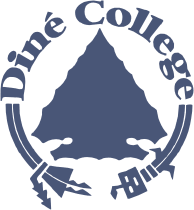Diné College
 | |
| Motto | The Higher Education Institution of the Navajo |
|---|---|
| Type | Tribal College |
| Established | 1968 |
| President | Dr. Charles “Monty” Roessel |
| Students | 2,000 |
| Location | PO Box 126 Tsaile, 86556 Arizona, USA |
| Mascot | Warrior |
| Website | Dinecollege.edu |
Diné College is a two-year, tribally controlled community college, serving the 27,000-square-mile (70,000 km2) Navajo Nation. Current enrollment is 1,830 students, of which 210 are degree-seeking transfer students for four-year institutions. Scholarships are available through the American Indian College Fund (AICF). Due to the low student-faculty ratio, personalized instruction is guaranteed to each student.[1]
Campus
The main campus of Diné College is in Tsaile, Arizona, an unincorporated community in Apache County, Arizona. There are also seven branches of Diné College on the reservation in Arizona (three in Apache County (Chinle, Ganado, and Window Rock), one in Coconino County (Tuba City), and one in Navajo County (Kayenta) and New Mexico (one in McKinley County (Crownpoint) and one in San Juan County (Shiprock)).
The main Tsaile campus includes eight fifteen-room dormitories housing about 150 students: each octagonally shaped unit has a fireplace in the center, and is described by the college as a "hooghan away from hogan"—a reference to the traditional Navajo hogan dwelling.
The residence life office is in Ch'ó (Spruce) Hall. Residence halls include:[2]
Co-ed:
- Deestsiin (Pinyon) Hall
- K'ai' (Willow) Hall
- Ndíshchíí' (Pine) Hall
- Sáá' (Maple) Hall
- T'iisbéí (Aspen) Hall (Honors)
Female only:
- T'iisbáhí (Elm) Hall
- T'iistsoh (Cottonwood) Hall
Male only:
- Tséch'il (Oak) Hall
Family housing:
- Gad (Juniper) Hall
Residents of family housing are zoned to the Chinle Unified School District. Tsaile Elementary School is in proximity to the university.[3] All Chinle USD residents are assigned to Chinle High School.
Governance
The college is directed by an eight-member Board of Regents confirmed by the Government Services Committee of the Navajo Nation Council. The name Diné comes from the traditional name for the Navajo, meaning "the people."
History
Diné College opened in 1968 as the "Navajo Community College", the first college established by Native Americans for Native Americans. The College was chartered by the Navajo Nation in 1968. The college was originally housed at the Rough Rock Community School in Rough Rock, Arizona, while the Tsalie campus was under construction.
Ned Hatathli was chosen as the first president of Navajo Community College in 1969 when the Tsaile campus opened for classes, however, his presidency ended tragically when he accidentally shot himself while cleaning his rifle on October 16, 1972.
Tommy Lewis became president in August 1992 and funding from the BIA was about $4 million per year. Under his leadership, funding from the BIA increased to almost $7.3 million by the year 2000. The Navajo Language and Culture Curriculum became widely popular at the Tsaile campus after the program saw increases in class enrollment, thus allowing the Board of Regents to implement the program throughout the institution. Under the 1994 Equity in Education Act, Diné College became a Land Grant Institution allowing the institution to receive funding from the Morrill Acts of 1862 and 1890.
During the Summer of 1997, the administration changed the name of the college from Navajo Community College to Diné College in order to better to represent the school's function as an institution of learning for the Diné/Navajo people.
In 1998, Diné College bestowed its first baccalaureate degrees under the Diné Teacher Education Program, accredited through a partnership with Arizona State University.[4]
In 1998, the Diné College Library was rededicated as the "Kinyaa'áanii Charlie Benally Memorial Library".
On May 21, 2011, the women's archery team made history by winning the United States college national championship in compound bow.[5] This is believed to be the first time a tribal college team has won a top-tier intercollegiate national championship event in any sport.
Programs
- The Center for Diné Studies goal is to apply Navajo Są́ʼąh Naagháí Bikʼeh Hózhóón principles to advance quality student learning through Nitsáhákees (Thinking), Nahatʼá (Planning), Iiná (Living) and Siihasin (Assurance) in study of the Navajo language, history, and culture in preparation for further studies and employment in a multi-cultural and technological world.
- The Uranium Education Program at the Shiprock campus is empowerment program for the Navajo centering on the study of radiation and environmental health issues arising from the aftermath of uranium mining/milling operations on the Navajo Nation, as well as other serious environmental issues.
Diné College offers bachelor's degrees in elementary education and tribal management.[6]
Degree programs
- (AA) Associate of Art:
- Business Administration
- Computer Information Systems
- Diné Studies
- Early Childhood Education
- Elementary Education
- Fine Arts
- Liberal Arts
- Navajo Language
- Social & Behavioral Science
- Social Work
- (AS) Associate of Science:
- Computer Science
- Environmental Sciences
- Biology Option
- General Science Option
- Health Occupation Option
- Mathematics Option
- Physics Option
- Public Health
- Public Health Ed Socio-Cultural Option
- Public Health Envir Public Health Option
- (AAS) Associate of Applied Science:
- Business Management
- Computer Science
- Office Administration
See also
Notes
- ↑ American Indian Higher Education Consortium Archived June 14, 2012, at the Wayback Machine.
- ↑ "Residence Life." Diné College. Retrieved on June 16, 2015.
- ↑ "Tsaile Campus Area Map" (Archive). Diné College. Retrieved on June 16, 2015.
- ↑ American Indian Higher Education Consortium Archived June 14, 2012, at the Wayback Machine.
- ↑ "US Intercollegiate Archery Championships". Retrieved 2011-07-01.
- ↑ American Indian Higher Education Consortium Archived June 14, 2012, at the Wayback Machine.
External links
Coordinates: 36°19′13″N 109°13′51″W / 36.32038°N 109.23088°W